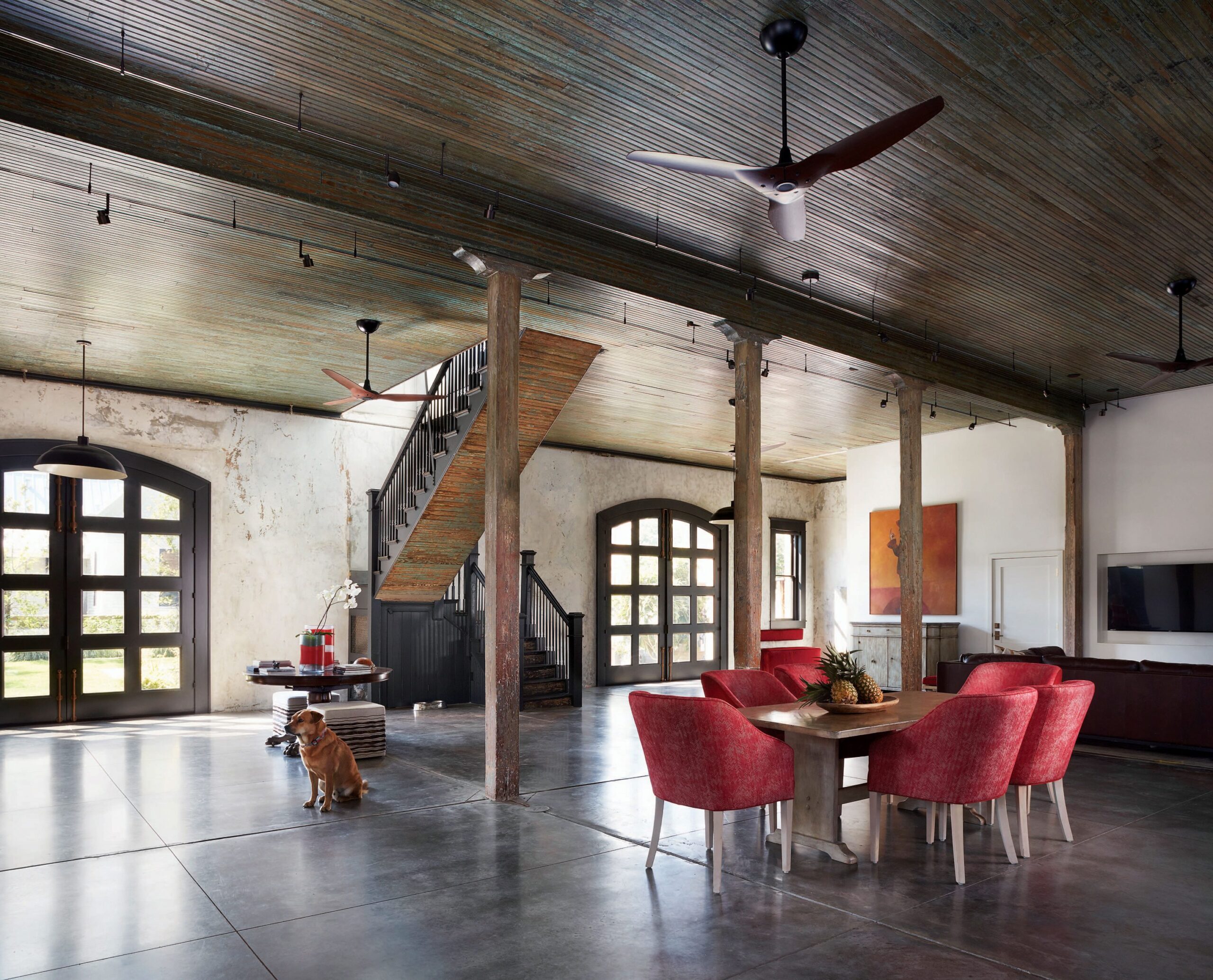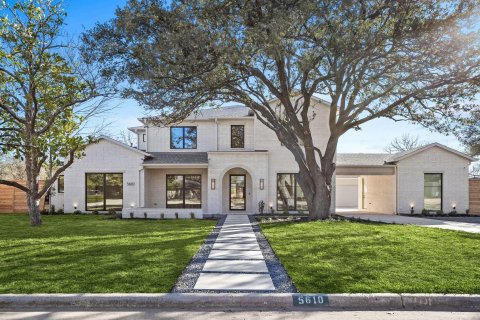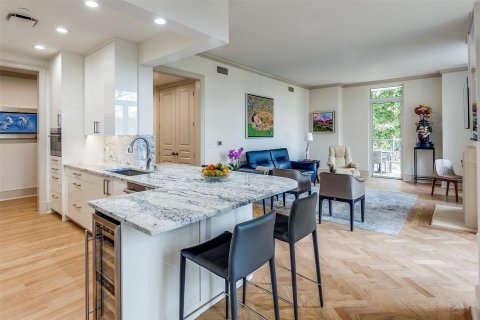How Saving a Historic Fire Station Changed an Entire Houston Neighborhood: A Win for Preservation and the Goodness of Human Nature
BY Rebecca Sherman // 04.08.18Firehouse No. 2 built in 1910. Exterior landscaping and pool design by Dorothee Sauter Helfenstein.
One Saturday morning in the fall of 2013, Michael Skelly and a good friend, architect Joseph Meppelink, were riding their bikes through Houston’s historic east end. “On a lark, I said, ‘Let me show you this cool old building,’ ” remembers Meppelink, who knew that Skelly and his wife, Anne Whitlock, were in the market to renovate an industrial building to live in.
For years, Meppelink had ridden past a boarded-up 100-year-old fire station and had once even asked around about buying it.
“I was told the owners would never sell,” he says. Still, it was worth taking another look. They pedaled to the dilapidated two-story structure and stopped. The brick was crumbling, and there were holes in the ceiling, but its stalwart dignity remained intact.
“As soon as Michael saw it, he said, ‘It’s perfect. Let’s see what we can find out.’ ” By that evening, Skelly had tracked down the owner’s name via HCAD, and early the next morning, the two were knocking on her door.
“She cracks it open and says, ‘Who are you?’ Meppelink recalls. “Michael is pretty easy to talk to and charismatic, so the next thing you know, they’re involved in a long conversation.”
The owner had inherited the fire station from her father, who’d recently passed away, and she was willing to sell — with one caveat. She had also inherited three big lots around it, and he’d have to buy those, too. Each of the lots had houses on them, and all were in terrible shape, Meppelink says. Eventually, a deal was struck to buy it all.
“Suddenly, our little renovation project had mushroomed into half a block,” says Whitlock. “We had no idea we were creating a community.”
For anyone who knows Anne Whitlock and Michael Skelly, it makes sense that they would save a historic fire station in an older immigrant neighborhood. The two had served in the Peace Corps, and after graduating from Harvard — Skelly with a degree in business, and Whitlock with a master’s in public policy — they devoted their lives to making a difference.
Skelly was an early pioneer in the wind energy business in the 1990s and now owns Clean Line Energy Partners, which builds high capacity lines connecting renewable energy to cities. Whitlock is the founding director of Connect Community, which serves diverse inner-city neighborhoods.
With three children headed to college, the couple had become empty nesters. “Our house in West University was a great place to raise kids,” Whitlock says, “but it was time to change things up.”
Renovations had already started on the fire station when they discovered six nearby Victorian houses slated for imminent demolition, as a developer made way for townhouses. They rescued those, too, and moved them onto the property. (The small houses that came with the property had neither architectural nor historic significance and were razed.)
“It was incredibly serendipitous, the way it all happened,” says Meppelink, who had been keeping an eye on the Victorians’ status for two years, hoping someone would buy them. Commissioned by Texas State Governor Francis Lubbock in 1861, the ornate shotgun-style Victorians were certainly worthy of preservation.
“That set us off on this extraordinary odyssey,” Whitlock says.
A Fire Station’s Rebirth
Built in 1910, Fire Station No. 2 served Houston at the dawn of a modern era, when horse-drawn carriages were starting to give way to motorcars. There’s evidence that one side of the station accommodated horse-drawn engines. An old-time firefighter who stopped by during renovations pointed out score marks on the concrete floor, which were designed to give traction to scrambling hooves as alarm bells rang. There are also remnants of old pegs on the columns, where harnesses and other tack were hung.
The station was decommissioned in the 1980s and fell into disrepair during the decades that followed. It took two years to bring it back to life, and at the same time, all six Victorian houses were being renovated. It was a massive undertaking. Meppelink, who owns Metalab Architecture, collaborated on the project with his wife, Marisa Janusz, of Janusz Design.
The Fire Museum of Houston was a tremendous resource, he says, providing archives and historic photographs. Almost all of the building’s original materials were retained, including the exterior load-bearing, 17-inch brick walls; staircase with original metal braces; worn plaster walls; and patinated bead-board ceilings.
The brass fire poles, which allowed firemen to slide quickly from the second floor to the first, were missing. They were replaced with a pair purchased from an early-1900s fire station in Boston that was undergoing renovation. A new concrete-slab floor was poured, and large bay doors were rebuilt, patterned after doors from the Fire Museum.
While the downstairs is designed to be more of a public venue, living quarters were created on the second floor, including bedrooms, kitchen, library, and living and dining rooms.
“We wanted the area where we live to be modern and clean,” Whitlock says. “So we hired an interior designer to help us figure out how to create a home out of such a cavernous space.”

Enter Martha Finger of Martha Baxter Interior Design. With 20-foot ceilings on the first floor and 10-foot ceilings upstairs, antique lighting fixtures had to be customized.
A too-narrow staircase meant furniture had to be craned into second-floor windows. To signal a transition from the historic first-floor environs to the private areas above, Finger mixed new materials with existing old ones. She hung a contemporary glass and- brass chandelier in the stairwell, and glass panels on the staircase and in the hallway divide space and let light in.
Black marble clads the fireplace, with brass detailing by local artisan James Dawson. In the kitchen, there are white marble counters and old black stone from Chateau Domingue on the floor.
“It feels like you are in a loft apartment in Soho,” Finger says. “It’s clean and white, but we tried to keep it homey.”
To cozy up the library, she painted it a deep aubergine, and covered the windows and a custom sofa in aubergine Holly Hunt fabric. Bookshelves in the hallway were designed from lumber salvaged from abandoned buildings in the neighborhood, and in the dining room, Finger commissioned a large wood table from Ben Baron and Jose Martinez of HTX Made, young artisans who recently set up shop in a warehouse next door to the fire station.
Much of the artwork and decorative pieces, such as African masks and antique zebra hide rug, came from the couple’s stints abroad with the Peace Corps.
“We have a lot of eclectic things,” Whitlock says. “We wanted the space to reflect our personalities — and to make sure it was a little quirky.”
Downstairs, they paid homage to the fire station’s history without going overboard. Still, they had a little fun with it — after all, the space is often used for fund-raisers and other events. An antique water hose, like the kind used on old fire-fighting engines, is displayed under a custom glass-topped table. The color red is used sparingly, but effectively: In the entry, a custom bench is decked out in red Cortina cowhide. The powder bath light fixtures hang from crimson ropes, and the kitchen faucet gleams red.
Whitlock and Skelly moved into Fire Station No. 2 in 2015 and immediately began integrating it into the neighborhood.
“One of our main goals was to keep the fire station accessible to the public, since it had once been a mainstay of the community and was a historic building,” Whitlock says. They’ve hosted neighborhood groups, a wedding, corporate retreats, and political fundraisers.
The antique fire poles, which bear marks from decades of fire fighters sliding down in their gear, are a crowd favorite. “We’ve had the Houston fire chief go down, and a candidate for senate go down. Everyone takes a turn,” says Whitlock.
Fire Station No. 2, along with the six Victorian houses in the back, are now woven into the fabric of the community in ways they never envisioned. One Victorian was sold to a young artist, and others have been rented out. A woman down the street was so inspired by all the neighborly goodwill that she, too, saved a couple of old houses and moved them onto her property.
When Hurricane Harvey devastated Houston, Whitlock and Skelly opened the fire station to an immigrant family and moved a disabled woman and her elderly mother into one of the Victorians. Skelly encouraged his Facebook friends to do to do the same, and many did, opening their doors to strangers in need. Whitlock reflects on the chain reaction their restoration project has had.
“It took 10 times as long and twice as much money,” she says, “but it’s been 100 times greater than we ever imagined.”































































